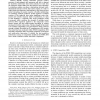Free Online Productivity Tools
i2Speak
i2Symbol
i2OCR
iTex2Img
iWeb2Print
iWeb2Shot
i2Type
iPdf2Split
iPdf2Merge
i2Bopomofo
i2Arabic
i2Style
i2Image
i2PDF
iLatex2Rtf
Sci2ools
IJCNN
2007
IEEE
2007
IEEE
Neural Network Ensembles for Time Series Prediction
— Rapidly evolving businesses generate massive amounts of time-stamped data sequences and defy a demand for massively multivariate time series analysis. For such data the predictive engine shifts from the historical auto-regression to modelling complex non-linear relationships between multidimensional features and the time series outputs. In order to exploit these time-disparate relationships for the improved time series forecasting, the system requires a flexible methodology of combining multiple prediction models applied to multiple versions of the temporal data under significant noise component and variable temporal depth of predictions. In reply to this challenge a composite time series prediction model is proposed which combines the strength of multiple neural network (NN) regressors applied to the temporally varied feature subsets and the postprocessing smoothing of outputs developed to further reduce noise. The key strength of the model is its excellent adaptability and gene...
| Added | 03 Jun 2010 |
| Updated | 03 Jun 2010 |
| Type | Conference |
| Year | 2007 |
| Where | IJCNN |
| Authors | Dymitr Ruta, Bogdan Gabrys |
Comments (0)

